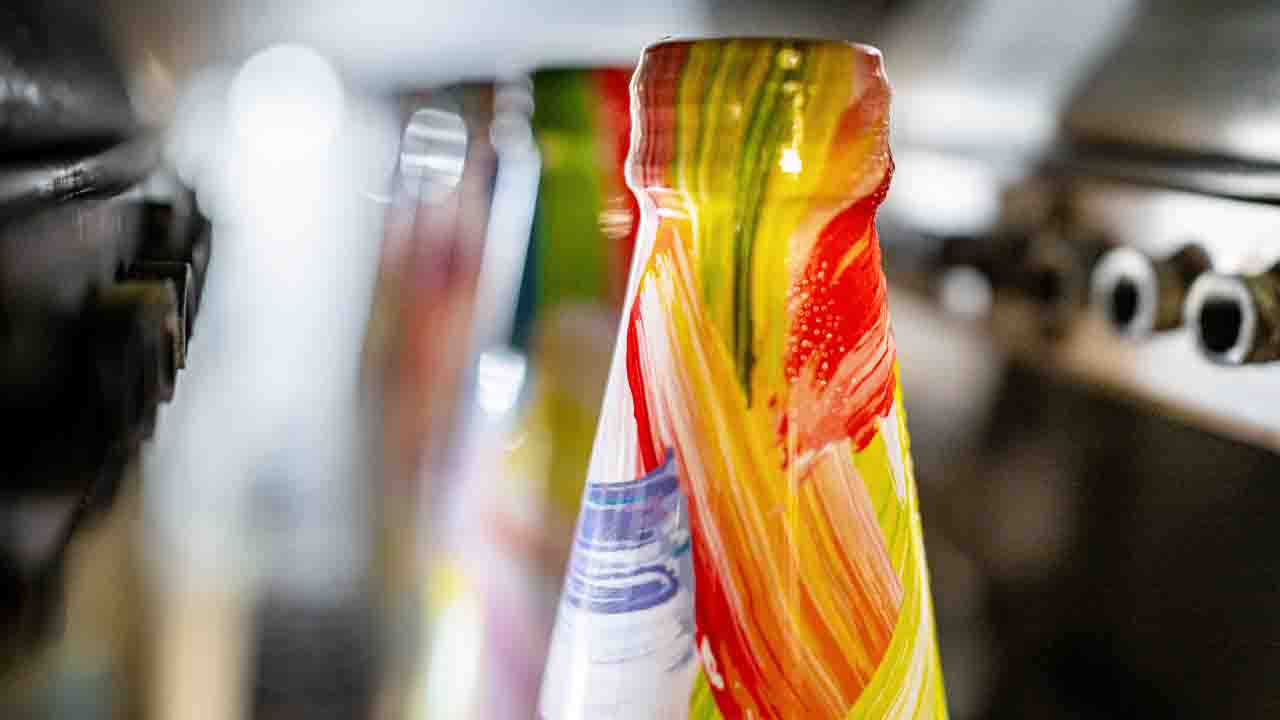Masterpress develops magnetizable inks for shrink
As packaging moves into a new era of sustainability, the finer details, including the ink used on labels, are becoming critical to the recyclability of the entire packaging,

In response to increasing regulatory pressure, Poland-based Masterpress, in collaboration with Magnomer and ink suppliers, has developed retentive inks and magnetizable inks for shrink sleeve applications. These inks aim to solve challenges in PET bottle recycling, where label separation and contamination hinder recycling and circularity.
Retentive inks
The development of retentive ink was driven by a challenge of ink bleeding during the caustic wash stage in the PET bottle recycling process. Conventional inks tend to dissolve into the washing solution, contaminating the water and making it harder to reuse or treat.
To combat this, Masterpress collaborated with ink suppliers to engineer an ink series that resists dissolving in caustic wash. These retentive inks are designed to remain adhered to the label surface even when exposed to high temperatures and chemical friction during the wash.
In the PET recycling system, when a bottle with a polyolefin label enters the caustic wash, the label and bottle can be separated due to their different densities. This separation is crucial for achieving a clean PET stream.
‘If the ink remains on the label, it’s much easier to remove the entire label cleanly,’ Masterpress’s research and development manager Katarzyna Wasilewska explains. ‘That way, the PET flakes are not contaminated, and they can be reused, even in applications like food-grade packaging.’
However, if the ink detaches from the label, it can behave unpredictably. ‘In theory, those ink particles should fl oat and be removed. But sometimes they sink, creating a risk of contaminating PET flakes. The best solution is for the ink to adhere to the label throughout the entire washing process,’ Wasilewska explains.
If the ink remains on the label, it’s much easier to remove the entire label cleanly
Masterpress emphasized that retentive inks are being developed for all label types and printing technologies.
Magnetizable inks
Magnetizable inks offer better label separation, particularly for PET-on-PET shrink sleeves, where both bottle and label are made from the same material and have the same density. Because they share identical densities and chemical properties, conventional flotation-based sorting techniques are inadequate.
Patented by Indian startup Magnomer, with Masterpress collaborating to optimize it for industrial use, magnetizable inks aim to solve this issue.
Wasilewska says: ‘Magnomer started developing a special magnetic coating for shrink sleeve labels used on PET bottles. The problem is that when both the bottle and label are made of PET, they cannot be separated in the recycling stream. They just behave the same way in the wash.’
If the PET label has a magnetic layer, it can be separated from the PET bottle fl akes using a magnet.
‘Since magnets are already part of existing recycling lines, used to extract steel or other metallic contaminants, recyclers don’t need any new infrastructure or investment. They just apply the same magnetization step to remove the labeled material,’ Wasilewska adds.
While recyclers primarily focus on recovering clean PET from the bottle itself, improving the label’s recyclability is a major bonus.
‘With this magnetic coating, we can ensure clean separation, enabling better recycling yields and less contamination,’ she notes.
The magnetizable layer remains adhered to the shrink sleeve label throughout the recycling process. The magnet pulls out the label flakes, leaving behind clean PET bottle flakes ready for reuse.
The magnetic layer is printed as a coating, either before or after the graphic artwork is applied. According to Wasilewska: ‘You wouldn’t be able to see the magnetic layer with the naked eye. It doesn’t affect the look, feel or print quality of the label.’
However, achieving the right magnetic force without compromising shrink performance was a challenge.
‘The strength of the magnetic properties depends on the ink layer’s thickness,’ Wasilewska explains. ‘Too thick, and the label won’t shrink properly. Too thin, and the magnetic effect is lost. So, we had to find that balance.’
For the magnetic sleeves to function effectively, the magnetic particles must be properly transferred to the PET substrate, which requires Masterpress to optimize the printing process.
The magnetic coatings are commercially available and have already been recognized by APR (Association of Plastic Recyclers) in the US as a recycling-friendly innovation. Europe has yet to adopt the technology formally, but with PPWR pushing the industry towards design for recycling, Masterpress is optimistic that adoption is not far off.
Stay up to date
Subscribe to the free Label News newsletter and receive the latest content every week. We'll never share your email address.


